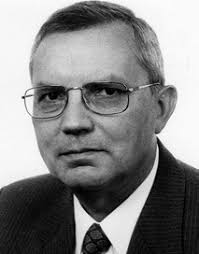Rudolf Herrmann (physicist)
Rudolf Herrmann (born May 11, 1936 in Berlin-Charlottenburg ) is a German physicist . He attended school in Jena , graduated from the Max Planck School in Berlin in 1954 and studied physics at the Humboldt University in Berlin .
Scientific life
His doctorate in 1964 took place at Moscow's Lomonossow University with a dissertation on Heisenberg's exchange interaction of ferromagnetics. From 1964 to 1968 he worked with Pyotr Leonidowitsch Kapiza on the electronic structure of solids and completed his habilitation in 1968 at the Humboldt University on Fermi surfaces of refractory metals and magnetic surface states in metals and semiconductors.
Scientific work
In 1968 he was appointed lecturer for experimental physics at the Humboldt University and in 1970 he was appointed professor for experimental physics at the chair for low temperature physics in the physics department of the Faculty of Mathematics and Natural Sciences. His work focused on the electronic structures of metals and semiconductors, superconductivity and the quantum Hall effect. From 1991 to 1992 he was visiting professor at the University of Paris "Pierre et Marie Curie", where he worked on the development of a low-temperature scanning tunneling microscope for the investigation of Abrikosov's magnetic vortex lattices. From 1998 to 2012 he worked at the Institute for Applied Photonics in Berlin-Adlershof with the development of cooling systems for the temperature range around 0.3 K for the cooling of detectors and with the storage of hydrogen in capillary systems.
Teaching
In addition to the diploma training, 33 physicists were doing their doctorates at his chair for low-temperature physics, ten of whom also completed their habilitation. He read the experimental lecture for the math-physics teacher students. He published his lectures on solid state physics together with Uwe Preppernau under the title "Electrons in Crystal" in the Akademie-Verlag Berlin and Springer-Verlag (Vienna and New York). During his activity as visiting professor at the Ritsumeikan University in Kyoto he read lectures on superconductivity, superfluids and solid state physics. As Vice Dean of Math.-Nat. Faculty of the Humboldt University he was chairman of the doctoral committee for non-medical students at the Charité in Berlin from the 1970s until 1990 and during the same period he also headed the Berlin School of Natural Sciences. Member of the German Physical Society was 1959. Member of the Leibniz Society for Sciences in Berlin.
The low temperature physics
This work "Die Tief Temperaturphysik" examines the developments in the physics of heat, especially low temperature physics, at the Humboldt University in Berlin. The author embeds the physical relationships and findings in the historical background and the political realities.
Beginning in the first half of the 20th century, the developments in physical and chemical research promoted by the German Empire are presented in Berlin. The changes and achievements up to the beginning of World War II as well as the efforts to catch up with these areas of science in the second half of the century after 1945 are then described. The experiences that the division of Germany and life and research in the GDR brought with it, as well as the progress in the field of low-temperature solid-state physics will then be examined. The book closes with a detailed description of the physical discoveries and advances made by Berlin researchers in the last decades of the 20th century.
In addition to the overall development of the scientific field, the work places a special focus on the research areas in Berlin, including the generation of low temperatures, the theory of thermodynamics and research into the structure of solid bodies. This also includes advanced topics such as the quantum Hall effect and superconductivity, the development of which is described in more detail in the last part of the book.
Private
Rudolf Herrmann was married to the physicist Karin Herrmann . The marriage had two children.
Individual references / publications
a. Original publications Of the more than 160 original papers, i. The Investigation of the Temperature Dependence of the Saturation Magnetization of Some Ferromagnetic Metals at Low Temperature VE Rode, R. Herrmann Proc. Int. Conf. on Magnetism, Nottingham 7th-11th September 1964, p. 146 ii. Oscillations of the surface impedance of tungsten in weak magnetic fields, R. Herrmann, phys. Stat. sol. 21 703 (1967) iii. Cyclotron resonance in molybdenum, R. Herrmann, Phys. Lett. 25A 607 (1967) iv. Cyclotron Resonance and Impedance Oscillations in Tellurium, R. Herrmann and Karin Herrmann, IX. Int. Conf. Phys. Semicond., Moscow July 23-29, 1968, Vol. 1 p. 322; phys. stat. sol. 25 655 (1968) v. The 2-Dimensional Electron Gas in Bicrystals, R. Herrmann, Solid Body Problems XXV 437 (1985) b. Monographs i.
Electrons in Crystal, Akademie-Verlag Berlin (1979) and Springer-Verlag, Vienna and New York (1979), together with Uwe Preppernau.
https://www.springer.com/de/book/9783709185216
ii.
The Low Temperature Physics of the Humboldt University in the 20th Century, (From Nernst's Heat Theorem to the Quantum Hall Effect) Springer Spectrum (2019)
https://www.springer.com/de/book/9783662595749
Web links
https://www.springer.com/de/book/9783662595749
| personal data | |
|---|---|
| SURNAME | Herrmann, Rudolf |
| BRIEF DESCRIPTION | German physicist |
| DATE OF BIRTH | May 11, 1936 |
| PLACE OF BIRTH | Berlin-Charlottenburg |


